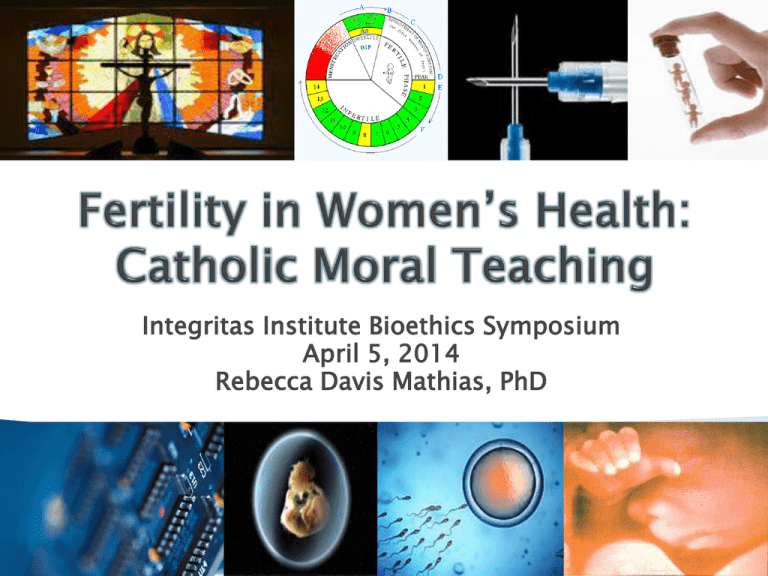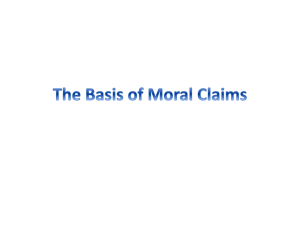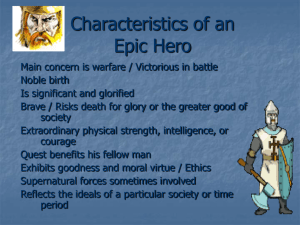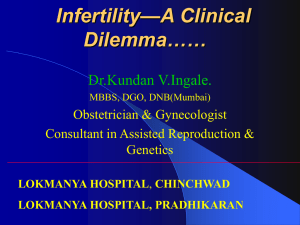Rebecca Davis-Mathias, Ph. D. - The Integritas Institute for Ethics
advertisement

Integritas Institute Bioethics Symposium April 5, 2014 Rebecca Davis Mathias, PhD Great burden for couples to bear Especially when they so deeply desire to have a child and live out their vocation to be open to life and welcome the gift of children from God Infertility treatment must respect God’s design for married love The Church, with sincere compassion and empathy . . . offers guidance and hope through her teachings On how to understand and approach infertility in a way that reverences and protects the dignity of the human person and respects God’s divine plan for married love. The challenge is to diagnose and address problems so these bodies can function as they should – and there is no moral problem in doing this, any more than there is in other medical treatments to restore health. (Life Giving Love in an Age of Technology) Moral teachings flow principally from the natural law, lex natualis, understood in the light of the revelation Christ has entrusted to his Church Natural law is a law written in the human heart, recognized by reason, a law distinct from the positive law of any State From this source, the Church has derived its understanding of the nature of: 1. The human person 2. Human acts 3. The goals that shape human activity When the marital act of sexual intercourse is not able to attain its procreative purpose, assistance that does not separate the unitive and procreative ends of the act, and does not substitute for the marital act itself, may be used to help married couples conceive. Those techniques of assisted conception that respect the unitive and procreative meanings of sexual intercourse and do not involve the destruction of human embryos, or their deliberate generation in such numbers that it is clearly envisaged that all cannot implant and some are simply being used to maximize the chances of others implanting, may be used as therapies for infertility. Heterologous fertilization (that is, any technique used to achieve conception by the use of gametes coming from at least one donor other than the spouses) is prohibited because it is contrary to the covenant of marriage, the unity of the spouses, and the dignity proper to parents and the child. Homologous artificial fertilization (that is, any technique used to achieve conception using the gametes of the two spouses joined in marriage) is prohibited when it separates procreation from the marital act in its unitive significance (e.g., any technique used to achieve extracorporeal conception). A Catholic health care institution that provides treatment for infertility should offer not only technical assistance to infertile couples but also should help couples pursue other solutions (e.g., counseling, adoption). 1. 2. 3. There is a moral order This moral order can be known What it means to be human is the basis of this moral order Act 2. Intention 3. Circumstances or Consequences 1. 1. 2. 3. Act What? Intention Why? Circumstances Who & to Whom? When? Where? How? Foreseeable Consequences? Viable Alternatives? Pope Paul VI’s July 25, 1968 Official, magisterial teaching of the Catholic Church On the regulation of birth Issue ignited controversy Prior to Vatican II (1962 – 1965) Prominent Catholic theologians raised questions Pope John XXII appointed a commission to study the subject It started with 6 men, mostly scientists Grew to over 60 members Including 4 women Dialogic for 3 years At end of commission’s 3rd meeting in 1964, Pope Paul VI urged group to: Continue its deliberations, listen to the anxiety of so many souls, and work diligently without worrying about criticism or difficulties. Prophesies that contraception would lead to: 1. Promiscuity 2. Sexual diseases [STIs] 3. Abortion 4. Divorce 5. Increasing anti-life mentality and culture The question of human procreation cannot be limited to mere scientific analysis The Church demonstrates a commitment to monitor and critique due respect for human dignity and human flourishing as technology progresses For example, in Caritas in Veritate Pope Benedict XVI advocates that the Church’s mission is primarily a moral and evangelical one and not a technical one of medicine or economics Great defender of HV Provides a personalist understanding of sexuality Theology of the Body Familiaris Consortio (1997) (1981) Promotes Natural Family Planning (NFP) Fertility is offered to one’s partner and lovingly received Fully human - it allows for transcendence of desire through self-control in the service of a higher good Fully giving and open to acceptance of children Blessed John Paul II claims that . . . Science and faith are not foreign to one another, but on the contrary, both need and reciprocally complement each other. . . We are now touching upon the autonomy of the sciences. Today the postulate of unlimited freedom in scientific research is often defended. In this regard, if on one hand [sic] it is necessary to recognize the right of the sciences to apply the methods of research that are proper to them; on the other, one cannot agree with the affirmation that the field of research itself is not subject to any limitations. The boundary is, precisely, the fundamental distinction between good and evil. This distinction takes place in [the person’s] conscience. Deep within the conscience men and women discover a law which they have not laid upon themselves but which they must obey. Its voice, ever calling them to love and to do what is good and to avoid what is evil, tells them inwardly at the right moment: do this, shun that. For people have in their hearts a law inscribed by God. Their dignity lies in observing this law, and by it they will be judged. Vatican Council II, Pastoral Constitution on the Church in the Modern World The ability to reason or discern well the moral decisions we face in our every day living Practical wisdom – well-informed Process of determining right from wrong Not a magic voice in our heads This doctrine, often set forth by the teaching authority, is founded upon the inseparable connection, willed by God, and which man cannot break on his own initiative, between the two meanings of the conjugal act: union and procreation. For, by its intimate structure, the conjugal act, while most closely uniting the spouses, enables them to procreate new lives according to laws inscribed in the very being of man and woman. It is by safeguarding these two essential aspects, union and procreation, that the conjugal act preserves in its fullness the sense of true mutual love and its ordination towards man’s most high calling to parenthood. From the moment of fertilization, the new life is a human being with unconditional respect and moral rights Because the embryo must be treated as a person, it needs to be cared for as any other human being Teachings allow for fertility medication to encourage ovulation (a source of many higher-order multiple births) Surgery to correct conditions like varicoceles and endometriosis Forbids procedures that substitute medical techniques for human intercourse Certainly, techniques aimed at removing obstacles to natural fertilization, as for example, hormonal treatments for infertility, surgery for endometriosis, unblocking of fallopian tubes or their surgical repair, are licit. All these techniques may be considered authentic treatments because, once the problem causing the infertility has been resolved, the married couple is able to engage in conjugal acts resulting in procreation, without the physician’s action directly interfering in that act itself. None of these treatments replaces the conjugal act, which alone is worthy of truly responsible procreation. No biologist or doctor can reasonably claim, by virtue of his scientific competence, to be able to decide on people's origin and destiny. This norm must be applied in a particular way in the field of sexuality and procreation, in which man and woman actualize the fundamental values of love and life. Pope Paul VI Institute - Omaha, NE Founded by Thomas W. Hilgers in 1985 Trains physicians to treat infertility in harmony with church teachings Adoption ? Infertility is not a problem to overcome, but can be an opportunity Embryonic stem cell research opposition is clearly prohibited Often relies on “left over” embryos from IVF Hormonal treatment with certain drugs have side-effects http://www.ivpcare.com/patient/ Pharmacy/products/prod_inf.asp? gclid=CLetqoWk3J0CFRYhDQodX DqeMQ Use of perforated condom to circumvent hypospadias LTOT – Low Tubal Ovum Transfer Moving sperm deposited in the vagina, uterus, fallopian tube Temporary removal of sperm or ova to “wash” or “capacitate” for relocation in the fallopian tube Accumulating sperm from a series of marital acts and introducing them into the wife’s vagina Sperm is conserved, concentrated and placed in wife’s generative tract in association with marital act SIFT (Sperm Intrafallopian Tube Transfer GIFT (Gamete Intrafallopian Tube Transfer) Some Catholic moral theologians like McCarthy, Griese, Cataldo, and Carlson defend GIFT Other Catholic moral theologians like Doerfler, Seifert, Demarco, Tonti-Filipini, Griesz, May and Ashley-O’Rourke are against it TOTS (Tubal Ovum Transfer with Sperm) Eventual success rate is roughly 50 – 70 % for all women Up to 86% for women under 35 Church documents highlight GIFT or ZIFT (Zygote Intrafallopian Transfer) Rarely used due to medical inferiority Reproductive Cycle can be $12,400 People who seek fertility treatment often feel vulnerable Goal = protect health and safety of individuals Ensuring reproductive techniques are safe and affordable Able to make informed decisions Morality - challenge about what is most deeply human and choices which are either lifeenhancing or life-diminishing Dignitatis Personae offers reasoned argument in support for the culture of modern science as “an invaluable service to the integral good of life and dignity of every human being.” (nos. 3 & 37) 8. Implement the Plan http://www.irh.org/nfp.htm http://nfpandmore.org/nfphowt o.shtml http://www.billingscentre.ab.ca/general/index.html http://familydoctor.org/online/f amdocen/home/women/contrac eptive/126.html US Conference of Catholic Bishops, http://www.usccb.org/issues-and-action/marriageand-family/natural-familyplanning/resources/infertility.cfm Paul VI, Humanae Vitae, no. 8, http://www.vatican.va/holy_father/paul_vi/encyclicals/ documents/hf_p-vi_enc_25071968_humanaevitae_en.html Congregation for the Doctrine of the Faith, Dignitas Personae, nos. 6 and 9, http://www.vatican.va/holy_father/paul_vi/encyclicals/ documents/hf_p-vi_enc_25071968_humanaevitae_en.html US Conference of Catholic Bishops, Ethical and Religious Directives for Catholic Health Care Services, 5th Ed., http://www.usccb.org/issues-and-action/human-lifeand-dignity/health-care/upload/Ethical-ReligiousDirectives-Catholic-Health-Care-Services-fifth-edition2009.pdf Congregation for the Doctrine of the Faith, Donum Vitae, (February 22, 1987), http://www.vatican.va/roman_curia/congregatio ns/cfaith/documents/rc_con_cfaith_doc_198702 22_respect-for-human-life_en.html. “Reproductive Technologies,” Natural Family Planning Program, United Stated Conference of Catholic Bishops, http://www.usccb.org/issuesand-action/marriage-and-family/naturalfamily-planning/catholicteaching/upload/Reproductive-technologies.pdf. Benedict XV1, Caritas in Veritate, http://www.vatican.va/holy_father/benedict_ xvi/encyclicals/documents/hf_benxvi_enc_20090629_caritas-inveritate_en.html Health Ethics Guide, (Ottawa, ON: Catholic Health Association), 2000, 81. John Paul II, Evangelium Vitae (March 25, 1995), http://www.vatican.va/holy_father/john_paul _ii/encyclicals/documents/hf_jpii_enc_25031995_evangelium-vitae_en.html, nos. 18-20, 44-45.










